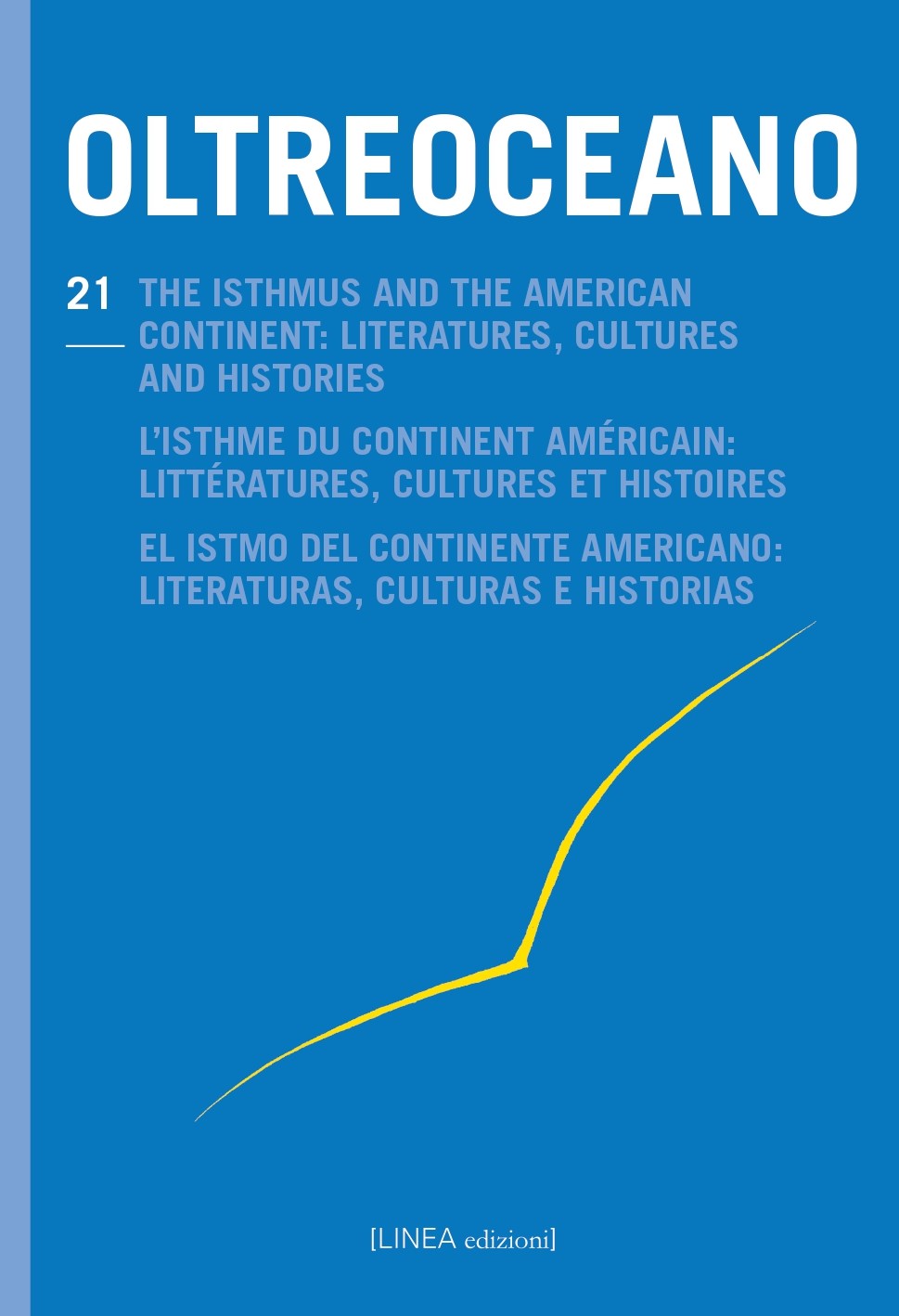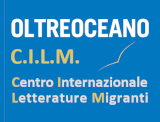Présence de l’Amérique latine dans La Maison des pluies de Pierre Samson: l’expression d’une “amérilatinité”
DOI:
https://doi.org/10.53154/Oltreoceano63Parole chiave:
Pierre Samson, écriture transmigrante, amérilatinité, Québec, Amérique LatineAbstract
Le romancier Pierre Samson a débuté sur la scène littéraire québécoise dans la deuxième moitié des années 1990, grâce à la trilogie dite “brésilienne” (Le Messie de Bélem, 1996; Un garçon de compagnie, 1997; Il était une fois une ville, 1999) qui s’inscrit dans le domaine de l’écriture transmigrante, catégorie censée abattre, d’après Gilles Dupuis, la frontière séparant la littérature migrante d’avec la littérature nationale. Cet article se penche sur le sixième roman de Samson, La Maison des pluies, paru en 2013, dans la perspective de souligner la manière dont il met en œuvre une pratique transmigrante. L’analyse de l’ouvrage, menée sur le plan des transferts thématiques et formels, convoque une réflexion identitaire qui s’appuie sur le concept d’amérilatinité forgé par Frédéric Lesemann. Le roman entraîne à repenser l’identité québécoise en termes transculturels et selon une dimension continentale à travers la représentation d’un espace québécois pluriculturel et plurilingue, la création d’un personnage salvadorien immigré au Québec, des références socio-historiques à l’Amérique Latine ainsi qu’à travers l’alternance codique que réalisent les dialogues et la voix du narrateur.
Latin America’s Presence in Pierre Samson’s La Maison des pluies: the Expression of “Amerilatinity”
The novelist Pierre Samson made his debut on the Quebec literary scene in the second half of the 1990s with the so-called “Brazilian trilogy” (Le Messie de Bélem, 1996; Un garçon de compagnie, 1997; Il était une fois une ville, 1999), which falls into the field of transmigrating writing, a category that, according to Gilles Dupuis, is supposed to break down the boundary between migrant and national literature. This article looks at Samson’s sixth novel, La Maison des pluies, published in 2013, in order to highlight the way in which it implements a transmigrant practice. The analysis of the text, carried out on the level of thematic and formal transfers, calls for a reflection on identity based on the concept of “amerilatinity” created by Frédéric Lesemann. The novel leads to a rethinking of the Quebec identity in transcultural terms and according to a continental dimension through the representation of a pluricultural and multilingual Quebec space, the creation of a Salvadorian character immigrated to Quebec, socio-historical references to Latin America as well as through the code-switching achieved by the dialogues and the narrator’s voice.
Presenza dell’America latina in La Maison des pluies di Pierre Samson: l’espressione di un’“amerilatinità”
Il romanziere Pierre Samson ha esordito sulla scena letteraria quebecchese nella seconda metà degli anni Novanta con la cosiddetta trilogia “brasiliana” (Le Messie de Bélem, 1996; Un garçon de compagnie, 1997; Il était une fois une ville, 1999), che rientra nel campo della scrittura “trasmigrante”, categoria che, secondo Gilles Dupuis, dovrebbe abbattere il confine tra letteratura migrante e nazionale. L’articolo analizza il sesto romanzo di Samson, La Maison des pluies, pubblicato nel 2013, allo scopo di evidenziare il modo in cui applica una pratica trasmigrante. L'analisi dell'opera, fondata su traslazioni tematiche e formali, conduce a una riflessione sull'identità basata sul concetto di “amerilatinità” introdotto da Frédéric Lesemann. Il romanzo porta a ripensare l'identità quebecchese in termini transculturali e secondo una dimensione continentale attraverso la rappresentazione di uno spazio quebecchese pluriculturale e multilingue, la creazione di un personaggio salvadoregno immigrato in Québec, alcuni riferimenti storico-sociali all'America Latina e l’alternanza linguistica realizzata dai dialoghi e dalla voce narrante.
Downloads
Riferimenti bibliografici
Bullock, B. & Toribio, A. J. (Éds.) (2009): The Cambridge Handbook of Code-Switching. Cambridge: Cambridge University Press.
Dupuis, G. (2004): Migrations et transmigrations littéraires au Québec: l’exemple brésilien. Trans. Internet-Zeitschrift für Kulturwissenschaften, 15. Tiré de https://www.inst.at/trans/15Nr/05_11/dupuis15.htm#t10 (Consulté le 14/04/2022).
Figueiredo, E. (2000): Représentation du Brésil dans la littérature québécoise contemporaine. Voix et Images, 25, 3, pp. 563-575.
Harvey, R. (2005, 13-14 août): De l’américanité à l’“amérilatinité”. Le Devoir, p. 2.
Hazelton, H. (1994): Quebec Hispánico: Themes of Exile and Integration in the Writing of Latin American Living in Quebec. Canadian Literature, 142-143, pp. 120-135.
Kwaterko, J. (2002): Les fictions identitaires des romanciers haïtiens du Québec. Revue de littérature comparée, 302, pp. 212-229.
Ouellet, F. (2003): Le nouveau roman québécois et la métaphore christique: fragments d’un discours amoureux. Laval théologique et philosophique, 59, 3, pp. 451-459.
Pruteanu, S. (2016): Entre l’Amérique du Nord et l’Amérique du Sud: création d’un nouveau métarécit québécois dans trois romans d’Alain Beaulieu. Studies in Canadian Literature /Études en littérature canadienne, 41, 1, pp. 143-161.
Samson, P. (1996): Le Messie de Bélem. Montréal: Les Herbes rouges.
Samson, P. (1997): Un garçon de compagnie. Montréal: Les Herbes rouges.
Samson, P. (1999): Il était une fois une ville. Montréal: Les Herbes rouges.
Samson, P. (2007): Catastrophes. Montréal: Les Herbes rouges.
Samson, P. (2010): Arabesques. Montréal: Les Herbes rouges.
Samson, P. (2013): La Maison des pluies. Montréal: Les Herbes rouges.
Samson, P. (2015): L’OEil de cuivre. Montréal: Les Herbes rouges.
Samson, P. (2016): Fiction et mémoire vive ou la dissipation d’un malentendu. Oltreoceano, 11, pp. 111-118.
Samson, P. (2017): De messie à homme chevauché: le nous révélé par l’autre. Littératures, 77, pp. 143-149.
Samson, P. (2019): Le Mammouth. Montréal: Héliotrope.
Turcotte, J (2013): La littérature latino-canadienne en traduction: zones de contact, zones de tension. TTR, 26, 1, pp. 73-102.
Downloads
Pubblicato
Come citare
Fascicolo
Sezione
Licenza

Questo lavoro è fornito con la licenza Creative Commons Attribuzione - Non commerciale - Condividi allo stesso modo 4.0 Internazionale.
Gli autori si impegnano a rispettare le seguenti condizioni, che s’intendono accettate al momento della sottomissione per la stampa dei propri contributi.
L’invio di un testo implica che esso sia inedito e non in attesa di essere pubblicato altrove.Gli autori si impegnano a rispettare le seguenti condizioni, che s’intendono accettate al momento della sottomissione per la stampa dei propri contributi.
- Qualora venga accettato, l’autore conferisce all’editore il diritto di pubblicarlo e distribuirlo sia in forma cartacea che nell’edizione elettronica in rete. Gli articoli pubblicati saranno scaricabili e resi disponibili in open access.
- Purché segnali correttamente che la prima pubblicazione è avvenuta sulla rivista «Oltreoceano. Rivista sulle migrazioni», l’autore ha facoltà di: a) riprodurre l’articolo in estratti separati o raccolti in volume; b) pubblicare l’articolo nel proprio sito personale o in quello di corsi di insegnamento purché si tratti di siti di natura non commerciale; c) depositare l’articolo in archivi online di carattere non commerciale, legati all’istituzione di appartenenza o come parte di progetti di diffusione non commerciale e open access dei lavori scientifici.
Non è consentita l’utilizzazione dei contributi da parte di terzi, per fini commerciali o comunque non autorizzati. L’editore declina ogni responsabilità sull’uso non autorizzato del materiale pubblicato sulla rivista.













